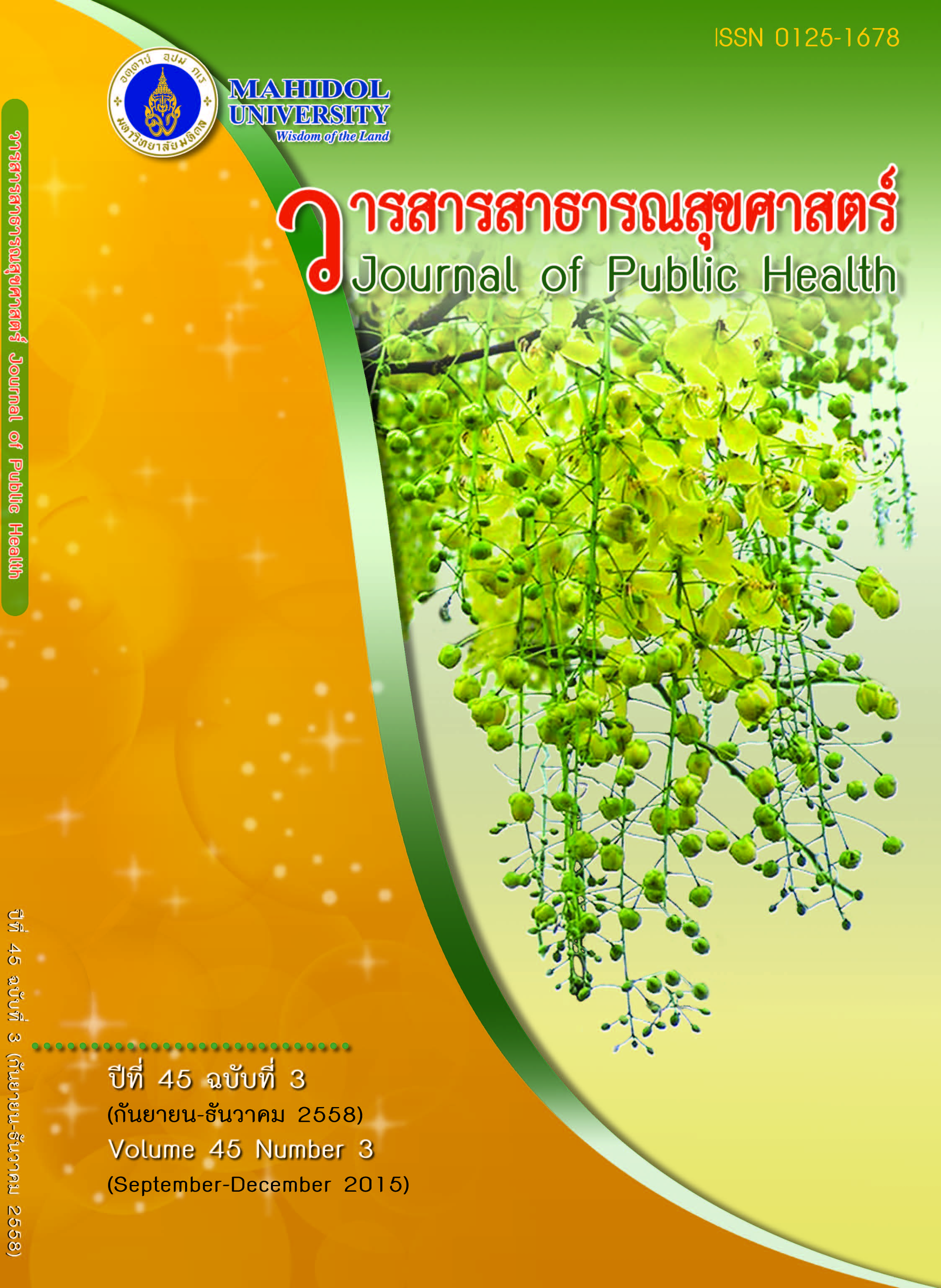พฤติกรรมเสี่ยงต่อการติดเชื้อเอชไอวีและปัจจัยที่มีความสัมพันธ์ กับการใช้ถุงยางอนามัยของวัยรุ่น
Keywords:
พฤติกรรมเสี่ยง, การใช้ถุงยางอนามัย, วัยรุ่น, เพศศึกษารอบด้าน, ทัศนคติ, Risk behaviors, condom use, teenagers, comprehensive sexuality education, attitudeAbstract
บทคัดย่อ
โรคเอดส์ยังคงเป็นปัญหาสาธารณสุขที่สำคัญของประเทศไทย วัยรุ่น ถือได้ว่าเป็นกลุ่มเสี่ยงที่สำคัญกลุ่มหนึ่ง การวิจัยนี้มีวัตถุประสงค์เพื่อสำรวจพฤติกรรมเสี่ยงต่อการติดเชื้อเอชไอวีและหาปัจจัยที่มีความสัมพันธ์กับการใช้ถุงยางอนามัยของวัยรุ่น ที่ได้รับการสอนหลักสูตรเพศศึกษารอบด้านจำนวน 16 คาบขึ้นไปต่อปีการศึกษา กลุ่มตัวอย่าง คือ วัยรุ่นที่เรียนอยู่ในโรงเรียนที่มีการดำเนินการจัดการสอนเพศศึกษารอบด้าน ระดับมัธยมศึกษาตอนต้นหรือตอนปลาย จำนวน 954 คน สำรวจใน 5 จังหวัด คือ กรุงเทพมหานคร อุดรธานี เพชรบุรี นครสวรรค์ และพัทลุง สุ่มตัวอย่างด้วยวิธีแบ่งกลุ่มชนิด 2 ขั้นตอน โดยขั้นตอนที่ 1 สุ่มโรงเรียนในแต่ละจังหวัด และขั้นตอนที่ 2 สุ่มห้องเรียนจากโรงเรียนที่สุ่มได้ เก็บข้อมูลระหว่างเดือนมิถุนายนถึงเดือนกรกฎาคม 2557 ผลการสำรวจพบว่า นักเรียนวัยรุ่นมีพฤติกรรมที่ค่อนข้างเสี่ยงต่อการติดเชื้อเอชไอวี มีความรู้ที่ถูกต้องตามตัวชี้วัดของ Global AIDS Response Progress Reporting ในระดับต่ำมาก ถึงแม้ว่าจะมีทัศนคติต่อถุงยางอนามัยในเชิงบวก แต่ไม่ได้ช่วยให้นักเรียนใช้ถุงยางอนามัยทุกครั้งที่มีเพศสัมพันธ์ นอกจากนี้ยังมีเพศสัมพันธ์ครั้งแรกเมื่ออายุยังน้อย เฉลี่ย 14.5 ปี และมีจำนวนคู่นอนเฉลี่ย 1.8 คน และเมื่อทำการทดสอบไคสแควร์ พบว่า การใช้ถุงยางอนามัยเมื่อมีเพศสัมพันธ์ครั้งแรก มีความสัมพันธ์อย่างมีนัยสำคัญทางสถิติ (p < 0.001) กับการใช้ถุงยางอนามัยของวัยรุ่น โดยมีโอกาสมากกว่าถึง 8.4 เท่า (OR = 8.4; 95% CI: 1.9-37.7) ที่จะใช้ถุงยางอนามัยอย่างสม่ำเสมอ เมื่อเทียบกับวัยรุ่นที่ไม่ใช้ถุงยางอนามัย เมื่อมีเพศสัมพันธ์ครั้งแรก อย่างมีนัยสำคัญทางสถิติ (p = 0.005) ผลการสำรวจชี้ให้เห็นว่า หลักสูตรเพศศึกษารอบด้าน ควรได้รับการพิจารณาขยายให้ครบทุกโรงเรียนทั่วประเทศ โดยเน้นเรื่องการมีเพศสัมพันธ์ที่ปลอดภัย การสอนและสาธิตการใช้ถุงยางอนามัย ซึ่งจะช่วยลดความเสี่ยงในการติดเชื้อเอชไอวีในวัยรุ่นได้
Risk Behaviors of HIV Infection andFactors Associated with Condom Use among Teenagers
ABSTRACT
Acquired Immune Deficiency Syndrome (AIDS) is still a major public health problem in Thailand. Teenagers are one of the risk groups. This study aimed to investigate risk behaviors of HIV infection and factors associated with condom use among teenagers who received comprehensive sexuality education (CSE) a minimum of 16 periods yearly. The sample size was 954 students who studied at the secondary or high school level, which implements the CSE. The survey was conducted in 5 provinces: Bangkok, Udon Thani, Phetchaburi, Nakhon Sawan and Phatthalung, from June-July 2014. Two-stage cluster sampling was employed, with the first stage as school sampling and the second stage as classroom sampling. Results revealed that students were likely to have risk behaviors of HIV infection such as very low level of correct answer to AIDS knowledge according to Global AIDS Response Progress Reporting indicators. Although the respondents had positive attitudes about condoms, they still did not use condoms consistently. In addition, the average age at first sex was 14.5 years and the average number of partners was 1.8. Condom use at first sex was significantly associated with condom use in teenagers (p <0.001). Students who used condom at first sex were 8.4 times (OR = 8.4; 95% CI: 1.9-37.7) more likely to use condoms consistently compared with those who did not use condoms at first sex (p = 0.005). Results indicated that CSE should be implemented in all schools across the country. Emphasizing safe sex, tutorial and condom use demonstrations should help to reduce the risk of HIV infection among teenagers.
Downloads
Issue
Section
License
Creative Commons License CC-BY-ND


